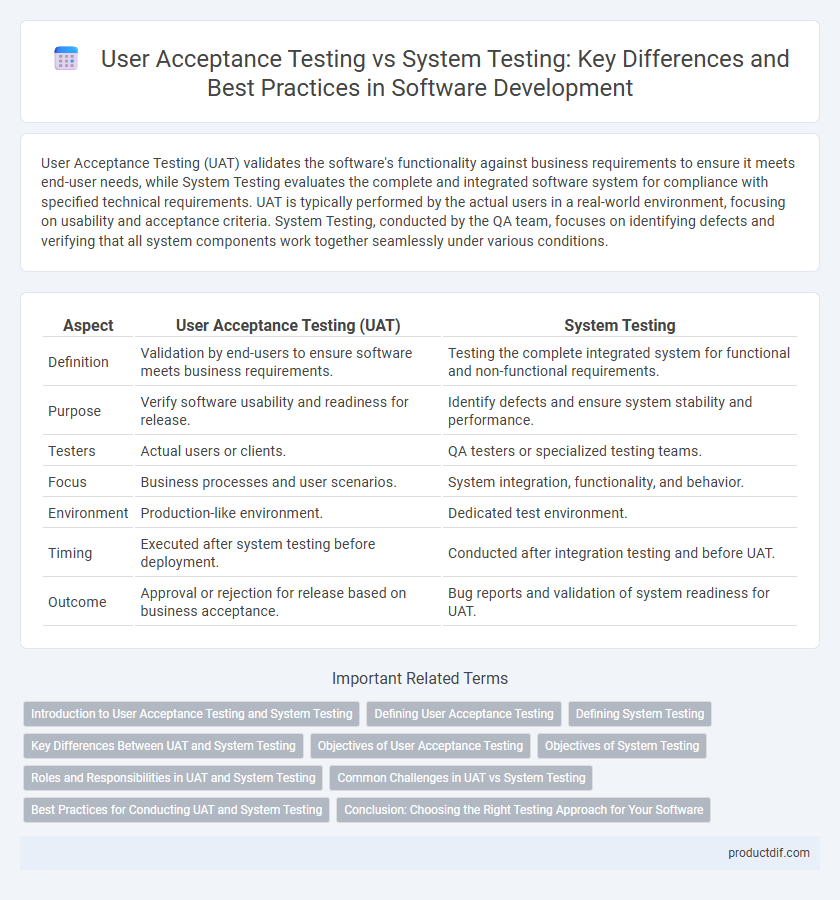User Acceptance Testing (UAT) validates the software's functionality against business requirements to ensure it meets end-user needs, while System Testing evaluates the complete and integrated software system for compliance with specified technical requirements. UAT is typically performed by the actual users in a real-world environment, focusing on usability and acceptance criteria. System Testing, conducted by the QA team, focuses on identifying defects and verifying that all system components work together seamlessly under various conditions.
Table of Comparison
| Aspect | User Acceptance Testing (UAT) | System Testing |
|---|---|---|
| Definition | Validation by end-users to ensure software meets business requirements. | Testing the complete integrated system for functional and non-functional requirements. |
| Purpose | Verify software usability and readiness for release. | Identify defects and ensure system stability and performance. |
| Testers | Actual users or clients. | QA testers or specialized testing teams. |
| Focus | Business processes and user scenarios. | System integration, functionality, and behavior. |
| Environment | Production-like environment. | Dedicated test environment. |
| Timing | Executed after system testing before deployment. | Conducted after integration testing and before UAT. |
| Outcome | Approval or rejection for release based on business acceptance. | Bug reports and validation of system readiness for UAT. |
Introduction to User Acceptance Testing and System Testing
User Acceptance Testing (UAT) verifies that software meets business requirements and user needs by simulating real-world scenarios before deployment. System Testing assesses the complete and integrated software to identify defects, ensuring all components function together as intended. UAT focuses on validation from the user's perspective, while System Testing emphasizes functional and non-functional system integrity.
Defining User Acceptance Testing
User Acceptance Testing (UAT) is the final phase in the software testing lifecycle where actual users validate the system's functionality against business requirements to ensure it meets real-world usage scenarios. UAT focuses on verifying usability, reliability, and compliance with end-user needs, distinguishing it from System Testing which primarily checks the software's technical performance and integration. The goal of UAT is to confirm the software is fit for release by simulating user environments and workflows before deployment.
Defining System Testing
System Testing is a comprehensive evaluation phase where the complete and integrated software application is tested against specified requirements to verify its overall functionality, performance, and security. Unlike User Acceptance Testing, which validates the software from the end-user perspective, System Testing focuses on detecting system-level defects and ensures all components work cohesively within the intended environment. This phase uses a variety of test types including functional, load, stress, and regression testing to validate system compliance before deployment.
Key Differences Between UAT and System Testing
User Acceptance Testing (UAT) validates that software meets business requirements and is ready for real-world use by end users, whereas System Testing evaluates the complete and integrated software system to ensure it functions correctly according to technical specifications. UAT focuses on user interface, usability, and workflow accuracy, while System Testing emphasizes functional correctness, performance, security, and integration of system components. The primary difference lies in UAT's role in confirming user satisfaction and business goals, contrasting with System Testing's objective to identify defects and verify system stability under various conditions.
Objectives of User Acceptance Testing
User Acceptance Testing (UAT) aims to validate that the software meets the business requirements and is ready for real-world use by end-users. It ensures that the system supports day-to-day operations and satisfies functional expectations from a user perspective. UAT focuses on verifying usability, performance, and compliance with user needs before deployment.
Objectives of System Testing
System Testing aims to validate the complete and integrated software product to ensure it meets specified requirements and functions correctly under real-world conditions. It evaluates system behavior, performance, security, and reliability across all components, identifying any defects before deployment. This phase confirms the software's readiness for release by simulating user environments and verifying end-to-end workflows.
Roles and Responsibilities in UAT and System Testing
User Acceptance Testing (UAT) roles primarily involve end-users and business analysts validating the software against business requirements to ensure it meets real-world usage and expectations. System Testing roles are assigned to quality assurance (QA) teams responsible for verifying the complete integrated system's functionality, performance, and security according to technical specifications. UAT focuses on user experience and acceptance criteria, while System Testing emphasizes defect identification, system integration, and compliance with design specifications.
Common Challenges in UAT vs System Testing
User Acceptance Testing (UAT) often faces challenges like unclear user requirements, inadequate test environment setup, and limited end-user involvement, which can lead to incomplete validation of business processes. System Testing struggles with issues such as integration complexities, identifying defects across different modules, and ensuring comprehensive test coverage of all system components. Both testing phases require meticulous planning and communication to address ambiguous requirements, environment inconsistencies, and incomplete test scenarios to ensure overall software quality.
Best Practices for Conducting UAT and System Testing
User Acceptance Testing (UAT) should focus on validating the software against real-world scenarios and business requirements, involving end-users to ensure the system meets their needs. System Testing requires comprehensive test cases covering functional, integration, performance, and security aspects to verify the complete system in a controlled environment. Best practices include early involvement of stakeholders in UAT planning, automated test scripts for system testing, and clear defect tracking to enhance software quality and delivery.
Conclusion: Choosing the Right Testing Approach for Your Software
User Acceptance Testing (UAT) ensures the software meets business requirements and user needs, while System Testing validates the overall functionality, performance, and security of the entire system. Selecting the right testing approach depends on project goals, timeline, and critical quality factors, balancing thorough system verification with real-world usability validation. Integrating both UAT and System Testing optimizes software quality, reduces deployment risks, and enhances stakeholder satisfaction.
User Acceptance Testing vs System Testing Infographic

 productdif.com
productdif.com